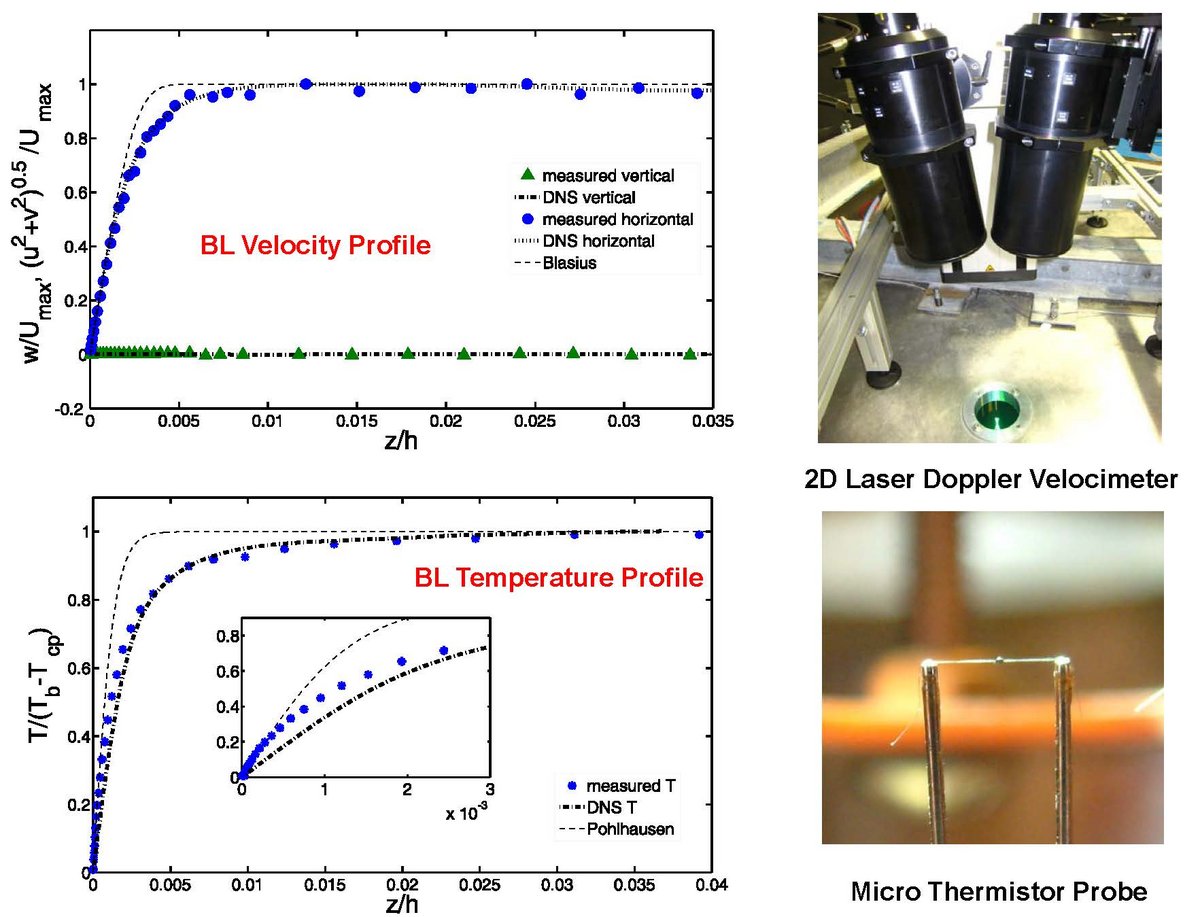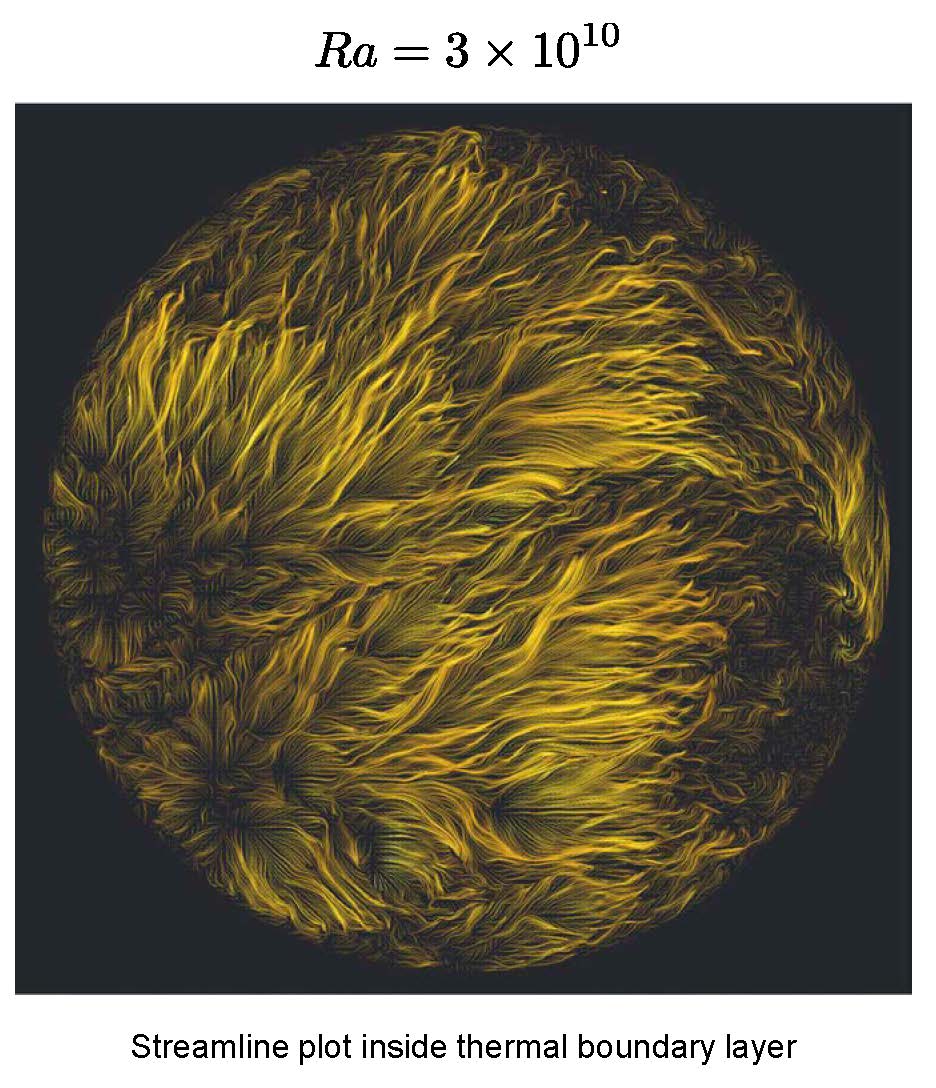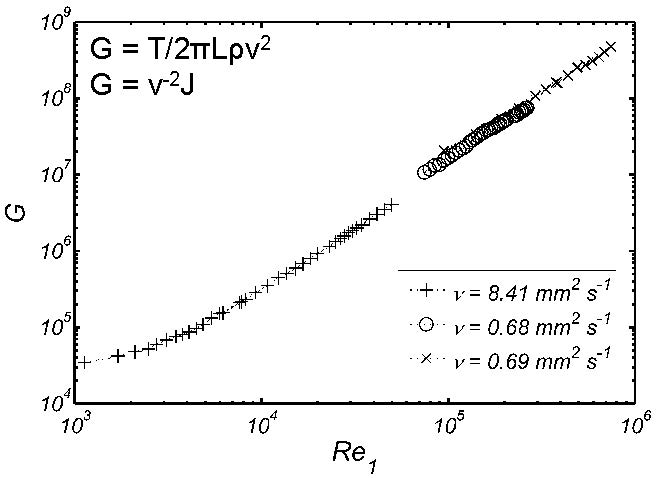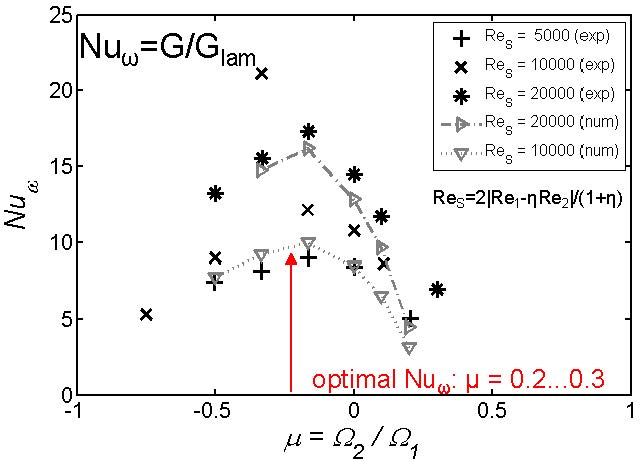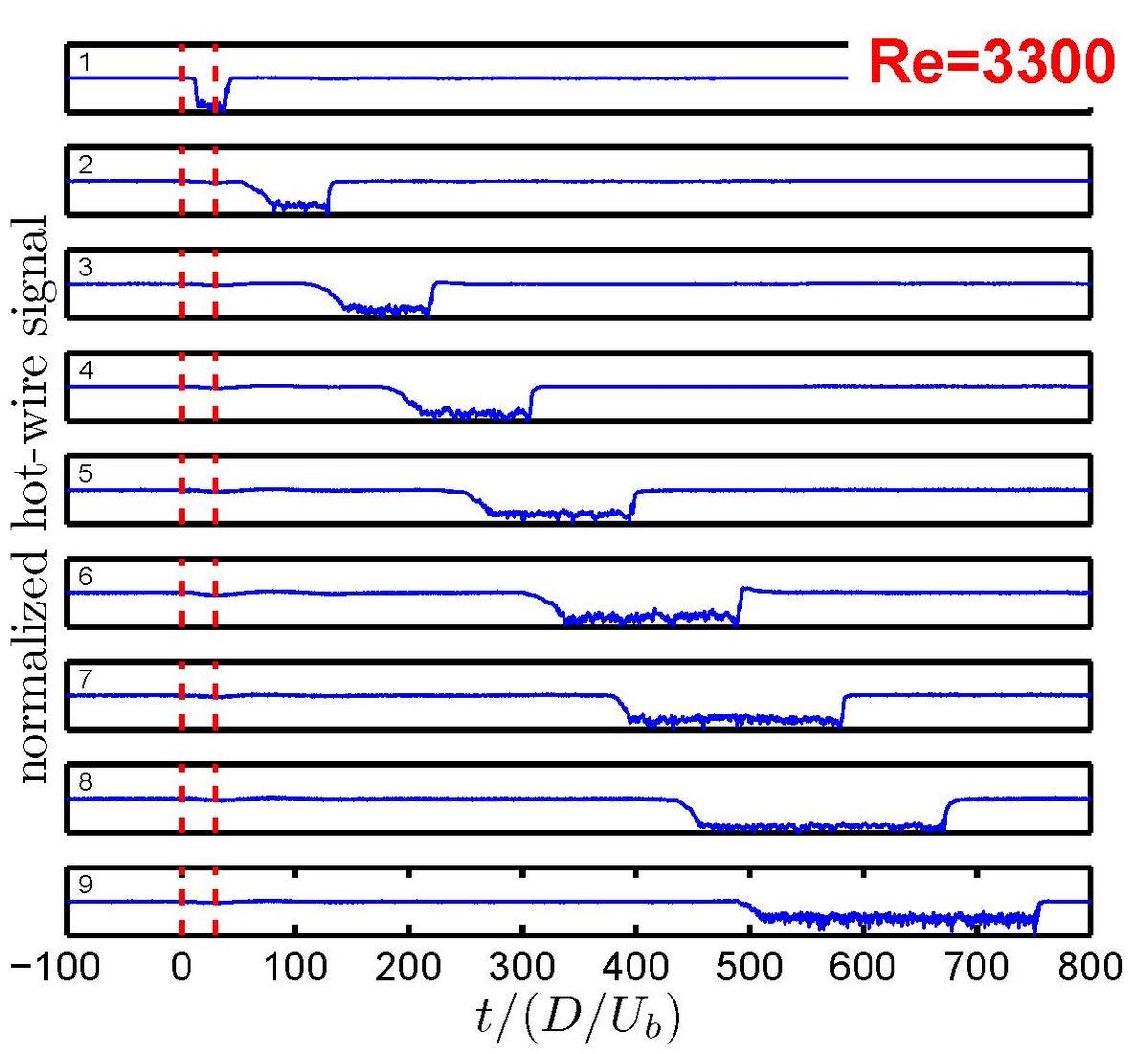State of Art (First Phase)
The Barrel of Ilmenau is actual the largest Rayleigh-Bénard experiment in the world. The object of this experiment is the investigation of the heat transport between cooled plate at the top and heated plate at the bottom. The diameter of this convection cell is 7.15m and the distance between heating and cooling plates can be adjusted from 0.7m till 6.3m. Regarding these geometrical properties, aspect ratios, which is the ratio between the horizontal and vertical dimension of the cell, from 1.13 till 100 are displaceable. Therefore small scale structures can be examined with commercial measurement techniques. The main interest is the dimensionless heat transfer, which is known as the Nusselt number. The Nusselt number is ratio between convective heat transfers in terms of the heat transfer in the absence of advection.
Using thermopiles the present heat flux will be investigated at the cooling and heating plate for different aspect ratios. Based on these measurements global structures can be observed (one role, double roles, multiple roles). The examination of the local heat flux will be realized with an infrared camera. For this an area-wide rubber layer (thickness around 5mm) will be bonded on the upper surface of the heating plate. Across this rubber layer a temperature drop will occur, which can be measured with the infrared camera. Based on Fourier's law the acting heat flux can be calculated. Beside the investigation of the global and local heat flux, the influence of the sidewall on the heat flux will be examined.
The “Barrel of Ilmenau” is with 7.14m diameter and 6.4m height. The large size of the barrel permits a high spatial resolution of temperature and velocity measurements at high Ra numbers, maximum Ra=1012, which has not been achieved before. The homogeneous temperature at the surface of the heating and the cooling plate and the adiabatic side wall promise us the exactness of the boundary conditions (The boundary layer thickness we can have is about several millimeters). The continuously variable aspect ratio, from 1.13 to 143, permits to model a broad variety of real flows. In order to reduce the Rayleigh number in the experiment matching the highest one in the simulations (Rasim=1010), we have installed a smaller sample with 2.5m diameter and 2.5m height in our big barrel. The 3-component Laser Doppler Anemometry velocity measurements in and outside the boundary layer have been carried out at the barrel. A direct comparison between experimental and numerical data can be realized in the first time at high Ra numbers.
In order to measure the torque at high Reynolds numbers of 106, a previously running Taylor-Couette facility was modified in several points. First, it was necessary to change the engines which drive the cylinders for reaching the desirable Reynolds numbers. The previous engines have been replaced by much stronger ones. Now, a 1.5 kW motor for the rotation of the outer cylinder and a 1.3 kW motor for the rotation of the inner cylinder rotation are available. Several modifications were also performed in order to improve the experiment stability. The measurements of torque at different rotation parameters are now possible. The torque working on the middle part of the inner cylinder is quantifiable by the strain gauges. The objective of the separation is to reduce the end effects of the solid end plates on the torque measurement. Slip rings transfer the signal out of the rotating cylinder into the convertor WZSG of the company Wachendorff sampling at a rate of 100 Hz. If only outer cylinder rotates (inner cylinder is at rest) will be reached significantly higher torques as expected. This phenomenon will be further investigated.
We are studying the torque for turbulent flows in a Taylor-Couette system for shear Reynolds numbers (Re) up to 30000 by means of direct numerical simulations. The computations are performed for an axially (spanwise) periodic domain with an aspect ratio (axial width/gap width) of 2. A system with a radius ratio (η) of 0.71 has been investigated as this enables direct comparisons to existing experimental torque data and to two experiments built by the other members of the Research Unit. For the investigated shear Reynolds numbers various global rotation states were realized. We tested the accuracy of the computations by three independent convergence criteria.
From these simulations both the transport of angular velocity, given by the angular velocity current, Jω, which provides a measure of the torque, and the volume energydissipation rate, ε, were studied. We analyzed the spatial and temporal fluctuations of the current on cylindrical cross-sections at the cylinder walls and in the middle of the gap where the fluctuations are comparatively much stronger. The pdf's of the spatial fluctuations at the cylinder walls compare well to experimental observations.
Our simulations reveal the emergence of a torque maximum for moderate counter-rotation when the Reynolds number approaches 30000. This maximum is known from experiments with significantly higher Reynolds numbers ( Re~105−106 ). Finally, the extraction of radial profiles of the mean angular velocity enables the identification of boundary-layer thicknesses, which can be connected to the functional dependence of the torque on the shear and global rotation.
Simultaneous to this work, we are also analyzing the limit where Taylor-Couette flow converges to rotating plane Couette flow for η→1. For the simulations we use a parallelized version of channelflow. Analogous quantities are comparatively investigated to determine the role of curvature in the dynamics.
RS-1
Despite the fact that fully-developed laminar pipe flow (PF) is linearly stable, in reality laminar-to-turbulent transition of flow start to occur in pipes at various Reynolds numbers (Re), depending on the existing disturbances in the flow. When a localized disturbance is induced in the flow, at low Re, certain flow structures starts to occur prior to transition and during transition. Among those flow structures, turbulent puff and slug structures have been known for a long time. Recently, it was shown numerically that large scale flow structures, the so called traveling waves (TW), occur prior to transition. Despite the numerical discovery of TW, it is still a challenge to investigate these flow structures experimentally, because of the lack of knowledge on the types and the amplitude of disturbances generating such structures. Moreover, the evolution of the transitional structures with increasing Re has not been fully understood. For example, whether TW evolve to a turbulent puff is not known, if it evolves, next it should be found whether only certain type of TW develops to a turbulent puff or slug. In the last decade at LSTM-Erlangen, the kinematical consideration on the anisotropy of velocity fluctuations have shown that anisotropy invariants of velocity fluctuations follow certain paths during transition. However, no effort has been made to converge the results obtained from the dynamics of the transitional flow structures and the kinematical considerations. Hence, the proposed project aims at investigating the generation mechanism of TW in pipes, their connection to turbulent transitional structures puff and slug and the border between them, the connection between the dynamical and kinematical findings on transitional structures, and at establishing strategies to control transition. The investigations will be of experimental nature. Velocity measurements with hot-wire anemometry and stereo PIV will be conducted, pressure transients will be measured for the direct determination of lifetime of puffs. Flow visualization coupled with pattern recognition and optimization algorithm will be employed to find optimum disturbance parameters for each type of TW, so that the connection between the disturbance and the generated TW will be efficiently established. This data would help to construct a map showing the border between the laminar and turbulent states. Being able to generate TW of different shapes in a reproducible manner allows us, at the second phase of the project, to investigate quantitatively the velocity field within the TW and in the development of TW along the pipe till it becomes turbulent. Hence, the data made available by the experiments would help to bridge the dynamical and kinematical considerations and construct strategies to control transition. Ultimately, the measured profiles of turbulent stresses and their anisotropy, probability and lifetime statistics, and the peculiarities of transitional flow structures will be analyzed together with those found in Taylor-Couette flows (TC) and Rayleigh-Benard convection (RB), to show the common transport mechanisms in those flows.
This project comprises three parts, which will be accomplished within 6 years:
Part 1
The dynamics and kinematics of puff, puff splitting and slug structures by hot-wire and pressure measurements with the available PF transition facility will be studied. A pipe with larger diameter will be employed with the same test-rig to have better spatial resolution of the hot-wire probes so that profiles of turbulent stresses and their anisotropies within transitional structures can be precisely measured.
Despite the fact that fully-developed laminar pipe flow (PF) is linearly stable, in reality laminar-to-turbulent transition of flow start to occur in pipes at various Reynolds numbers (Re), depending on the existing disturbances in the flow. When a localized disturbance is induced in the flow, at low Re, certain flow structures starts to occur prior to transition and during transition. Among those flow structures, turbulent puff and slug structures have been known for a long time. Recently, it was shown numerically that large scale flow structures, the so called traveling waves (TW), occur prior to transition. Despite the numerical discovery of TW, it is still a challenge to investigate these flow structures experimentally, because of the lack of knowledge on the types and the amplitude of disturbances generating such structures. Moreover, the evolution of the transitional structures with increasing Re has not been fully understood. For example, whether TW evolve to a turbulent puff is not known, if it evolves, next it should be found whether only certain type of TW develops to a turbulent puff or slug. In the last decade at LSTM-Erlangen, the kinematical consideration on the anisotropy of velocity fluctuations have shown that anisotropy invariants of velocity fluctuations follow certain paths during transition. However, no effort has been made to converge the results obtained from the dynamics of the transitional flow structures and the kinematical considerations. Hence, the proposed project aims at investigating the generation mechanism of TW in pipes, their connection to turbulent transitional structures puff and slug and the border between them, the connection between the dynamical and kinematical findings on transitional structures, and at establishing strategies to control transition. The investigations will be of experimental nature. Velocity measurements with hot-wire anemometry and stereo PIV will be conducted, pressure transients will be measured for the direct determination of lifetime of puffs. Flow visualization coupled with pattern recognition and optimization algorithm will be employed to find optimum disturbance parameters for each type of TW, so that the connection between the disturbance and the generated TW will be efficiently established. This data would help to construct a map showing the border between the laminar and turbulent states. Being able to generate TW of different shapes in a reproducible manner allows us, at the second phase of the project, to investigate quantitatively the velocity field within the TW and in the development of TW along the pipe till it becomes turbulent. Hence, the data made available by the experiments would help to bridge the dynamical and kinematical considerations and construct strategies to control transition. Ultimately, the measured profiles of turbulent stresses and their anisotropy, probability and lifetime statistics, and the peculiarities of transitional flow structures will be analyzed together with those found in Taylor-Couette flows (TC) and Rayleigh-Benard convection (RB), to show the common transport mechanisms in those flows.
This project comprises three parts, which will be accomplished within 6 years:
The dynamics and kinematics of puff, puff splitting and slug structures by hot-wire and pressure measurements with the available PF transition facility will be studied. A pipe with larger diameter will be employed with the same test-rig to have better spatial resolution of the hot-wire probes so that profiles of turbulent stresses and their anisotropies within transitional structures can be precisely measured.
Investigations of the dynamics and kinematics within each kind of TW and other transitional structures with the help of stereo PIV measurements will be performed.
Hierarchical occurrence of turbulent transitional structures
The first part of the project was planned to be conducted by the existing transition pipe-flow facility of LSTM-Erlangen. However, preliminary studies have shown that determination of Reynolds number and reliable operation of disturbance unit during a measurement campaign, which lasts more than a week, becomes a bottle neck. Hence, the facility is equipped with extra pressure transducer for accurate determination of the Reynolds number and the disturbance unit is further modified to enhance its reliability. Hence, through integration of all equipments via a comprehensive DAQ program, it was possible to conduct long time measurements. With the introduction of the automatic structure recognition algorithm, the occurrence probability of different types of turbulent transitional flow structures could be detected at the end of pipes with different pipe lengths.
Tracking the turbulent transitional structures
The probability statistics obtained with the present facility were not matching to those available in the literature. It was suspected that the kind of disturbance introduced in our facility may not be generating each time turbulent structure. Hence, it was decided to follow each disturbance along the pipe and increase the consistency in our evaluation. For this purpose a hot-wire sensor is developed. This sensor is simply a wire stretched along the complete diameter and had its heated portion only at the center of the pipe. By selecting a very thin wire, the maximum Re number about the wire is kept below 100 hence, flow is not allowed to generate an unsteady wake. At the moment only 8 sensors and bridges are available. Measurements conducted with this system show how a disturbance evolves along the pipe. It is observed that disturbances can decay (Re < 2200) start to grow (Re > 2200) through multiple splitting and merging. Furthermore, the dependency on the disturbance type cannot be neglected.
Our preliminary experiments have shown that the length of our pipe is not sufficient to investigate the dissipation regime (Re < 2200). Moreover, splitting is a question of travel time of the structures. Therefore, we are now building a 48 m pipe (3200 D) along which 35 sensors will be installed with which we can track each disturbance induced on the flow.
Generation of travelling waves
Two more PhD students were engaged to conduct the investigations in Part 2 and Part 3. They are financed by Erlangen Graduate School of Optical Technologies and DAAD. They are going to modify the swirling pipe flow facility for the study of travelling waves. Initial focus will be on the optical visualization technique, pattern recognition and development of the disturbance unit.
The three-dimensional flow structures that occur at saddle-node bifurcations discovered by us in 2003 (so called traveling-waves) open a new research direction to understand and describe the transient states. In our numerical simulations these structures appear at Reynolds numbers below 800, while in experiment there appear for Reynolds numbers above 1600. The aim of our project is to perform numerical simulations at medium and low Reynolds numbers trying to clarify the discrepancy between theory and experiment as well as to investigate the stability properties of travelling-wave-type-solutions in pipe Poiseuille flow. In the second phase of the project the focus will be on identifying the global bifurcations, on characterizing the behaviour near the critical point, on developing methods to stabilize travelling waves numerically and experimentally (in collaboration with RS-2), and on developing reduced models of pipe flow.

